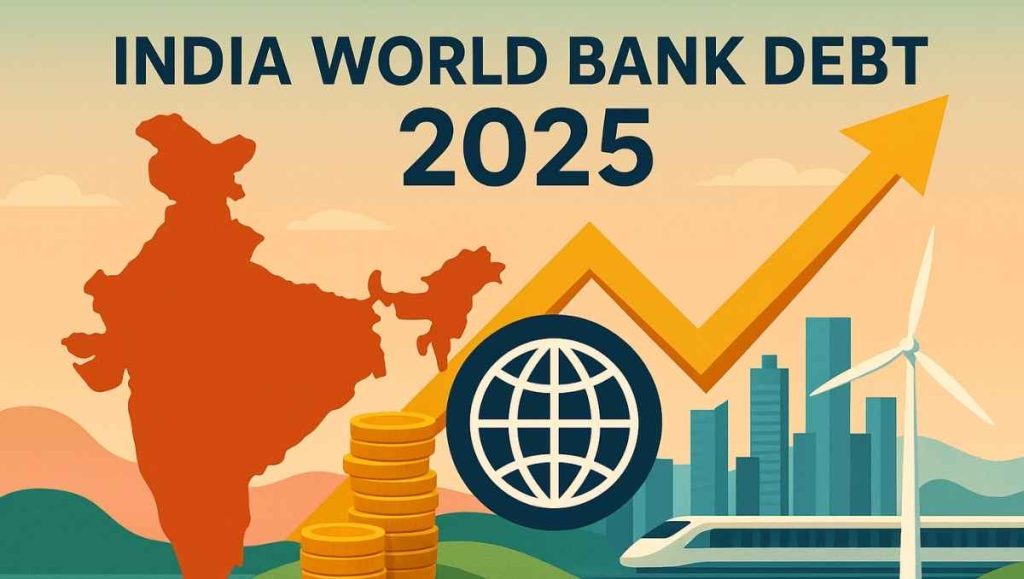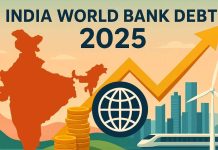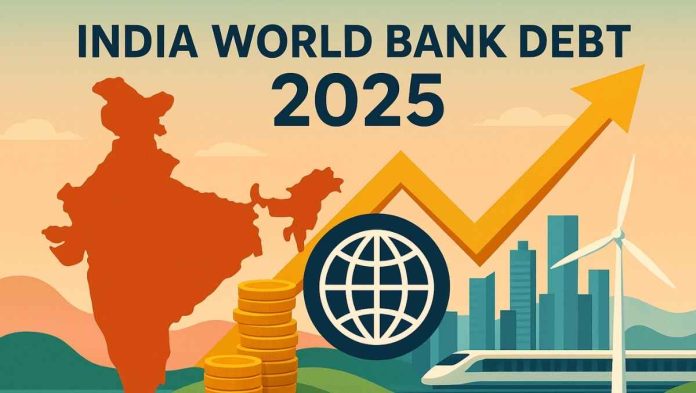India’s Growing Financial Footprint in Global Lending
In a striking revelation, the World Bank’s 2023–24 report lists India as the largest debtor nation, with outstanding loans exceeding $38 billion(approx). While this number may appear alarming, economists suggest that India’s debt relationship with the World Bank is not a sign of distress but rather of aggressive development financing.
As one of the fastest-growing major economies, India continues to borrow for infrastructure, digital transformation, renewable energy, and poverty reduction. But what does being the World Bank’s top borrower mean for India’s long-term economic stability? Let’s explore.
India’s Position on the Global Debt Map
According to data compiled by FDI Intelligence and the World Bank’s International Debt Statistics (IDS), India leads the list of the top 10 debtor nations in 2023:
| Rank | Country | Outstanding Debt (approx.) |
|---|---|---|
| 1 | India | $39.3 billion |
| 2 | Indonesia | $20.6 billion |
| 3 | Bangladesh | $18.2 billion |
| 4 | Pakistan | $18 billion |
| 5 | China | $15.6 billion |
| 6 | Brazil | $15.4 billion |
| 7 | Mexico | $15.1 billion |
| 8 | Colombia | $15 billion |
| 9 | Vietnam | $14.8 billion |
| 10 | Nigeria | $14 billion |
This data combines loans from the International Bank for Reconstruction and Development (IBRD) and the International Development Association (IDA)—both arms of the World Bank.
India’s loans are predominantly project-based, targeting long-term development in transport, energy, education, health and digital inclusion.
Why Is India the Largest Borrower?
1. Massive Infrastructure Development Needs
India’s push for infrastructure modernization is one of the primary reasons for high World Bank borrowing. With programs like:
- PM Gati Shakti Mission
- Bharatmala and Sagarmala projects
- National Infrastructure Pipeline (NIP)
- Smart Cities Mission
The government requires continuous external financing to meet funding gaps. World Bank loans provide long-term, low-interest capital that fuels roads, ports, railways, and logistics upgrades.
2. Energy Transition and Climate Commitments
India is leading one of the world’s most ambitious clean energy transitions. To meet its Net Zero by 2070 commitment, India is investing heavily in:
- Solar and wind energy projects
- Electric vehicle ecosystems
- Green hydrogen development
- Rural electrification programs
The World Bank, along with the Asian Development Bank (ADB) and Green Climate Fund, has been instrumental in supporting this shift through concessional loans and grants.
3. Poverty Reduction and Social Welfare
The World Bank supports multiple social sector projects, including:
- PM Awas Yojana (housing)
- National Rural Health Mission
- Digital Public Infrastructure initiatives
- Skill India and rural employment programs
These projects aim to uplift millions from poverty and bridge inequality gaps, aligning with the World Bank’s twin goals of ending extreme poverty and boosting shared prosperity.
4. Support During Economic Shocks
During the COVID-19 pandemic, India received emergency financing for healthcare and social protection programs. In 2020–21 alone, the World Bank approved over $2.75 billion in aid packages for India’s COVID response, vaccination logistics, and MSME revival schemes.
The Composition of India’s World Bank Debt
World Bank lending to India primarily comes from two entities:
| Institution | Type | India’s Outstanding Debt (approx.) | Purpose |
|---|---|---|---|
| IBRD (International Bank for Reconstruction and Development) | Non-concessional loans | ~$21 billion | Large-scale infrastructure, economic reform |
| IDA (International Development Association) | Concessional / low-interest | ~$17 billion | Rural and social development, health, education |
This composition highlights that India borrows strategically — balancing between low-cost and market-based finance to sustain long-term growth.
How Does India Manage Its Debt Efficiently?
Despite topping the World Bank debt list, India’s debt-to-GDP ratio remains manageable compared to global peers.
Key Metrics (as of FY 2024–25):
- Public debt-to-GDP ratio: ~81%
- External debt (total): $663 billion
- World Bank share: ~6% of total external debt
- Foreign exchange reserves: $645 billion (as of Sept 2025)
These numbers suggest that India’s debt servicing capacity is strong. The country’s FX reserves cover nearly 10 months of imports and over 90% of short-term external debt, offering a strong cushion against global volatility.
The Economic Logic Behind Borrowing

1. Cheaper Financing for Long-Term Projects
World Bank loans typically have low interest rates and long repayment periods (20–30 years), allowing India to fund projects that may take years to yield results—such as infrastructure and education reforms.
2. Catalyst for Private and Institutional Investment
World Bank involvement acts as a seal of credibility, encouraging private investors and other multilateral agencies to co-fund projects in India.
3. Technology and Policy Expertise
Beyond money, World Bank projects come with technical expertise in project management, governance, and sustainability — helping India adopt global best practices in public administration.
Key World Bank–Supported Projects in India (2020–2025)
| Project | Funding (Approx.) | Sector |
|---|---|---|
| Clean Energy Finance Project | $1.2 billion | Renewable Energy |
| National Education Mission Support (STARS) | $500 million | Education |
| Ganga River Basin Project | $800 million | Environment |
| Rural Road Connectivity Program | $1 billion | Infrastructure |
| PM e-Vidya Digital Learning Project | $350 million | Education |
| Ayushman Bharat Health Systems Strengthening | $750 million | Health |
| Rail Logistics Modernization | $1 billion | Transport |
These initiatives form the backbone of India’s development transformation strategy.
Risks and Concerns: Is Too Much Debt Dangerous?
While India’s borrowing is development-oriented, economists caution against complacency. Rising debt levels can pose medium-term risks if growth slows or fiscal discipline weakens.
1. Exchange Rate and Interest Rate Volatility
If global interest rates rise (as they did post-2022), debt servicing costs increase, particularly for IBRD-linked loans tied to variable rates.
2. Fiscal Deficit Pressures
India’s fiscal deficit target for FY 2025–26 is around 5.1% of GDP. Excessive borrowing, even if concessional, can strain the budget and limit spending on welfare.
3. Debt Sustainability Concerns
While manageable now, debt must generate productive returns—roads, schools, and clean energy that yield economic output—to avoid turning into a burden.
The Reform Response: India’s Economic Resilience Strategy
The Government of India has been proactive in ensuring debt sustainability through a mix of policy reforms, fiscal prudence, and structural transformation.
1. Fiscal Consolidation Path
The Union Government india aims to reduce the fiscal deficit to below 4.5% of GDP by FY 2027–28, signaling strong intent to manage borrowing responsibly.
2. Boosting Domestic Revenues
- Expansion of the GST network
- Improved tax compliance via Digital India initiatives
- Monetization of public assets under the National Monetization Pipeline (NMP)
These measures strengthen fiscal capacity without over-reliance on external debt.
3. Export-Led Growth and FDI
India’s strategic focus on manufacturing (Make in India 2.0), semiconductor investment, and trade diversification helps boost foreign exchange earnings, which in turn enhances debt repayment capacity.
4. Green Growth Transition
With World Bank support, India is becoming a global hub for green finance, launching green bonds and sustainable energy funds that attract international capital without heavy borrowing.
Expert Perspectives
Dr. Raghuram Rajan (former RBI Governor) has previously noted that “India’s external debt position remains comfortable due to prudent management, diversified sources of borrowing, and large reserves.”
Meanwhile, World Bank India Director Auguste Tano Kouame said in 2024:
“India’s partnership with the World Bank is among the most extensive globally, driven not by distress, but by ambition—to transform its economy in a sustainable, inclusive way.”
Public Perception: Is Borrowing Good or Bad?
There are Many Indians view external debt as a sign of weakness, but the reality is more nuanced. Borrowing from the World Bank is not like taking loans from commercial lenders or IMF bailouts. These funds are earmarked for developmental projects, with favorable terms and long gestation benefits. In essence, India borrows to grow, not to survive.
India’s Future Debt Strategy (2025–2030)
Looking ahead, India’s Ministry of Finance and NITI Aayog are working closely with the World Bank to design a next-generation financing model focused on:
- Green Growth and Climate Resilience
- Urban Development and Housing
- Water Security and Sanitation
- Digital Public Infrastructure (DPI)
- Women’s Economic Empowerment and Skill Development
This future-oriented approach ensures that India’s debt remains productive, not punitive.
Debt as a Tool for Development
India’s position as the World Bank’s top debtor in 2025 is not a warning sign—it’s a badge of development ambition. The borrowed funds are strategically invested in nation-building, climate resilience, and digital transformation that will yield returns for decades. As long as borrowing remains transparent, efficient, and growth-oriented, India’s debt will serve as a catalyst for inclusive progress, not a constraint.


































